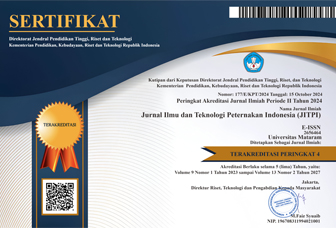Perubahan Status Fisiologis dan Bobot Badan Sapi Bali Bibit yang Diantarpulaukan dari Pulau Lombok ke Kalimantan Barat
DOI:
https://doi.org/10.29303/jitpi.v2i1.17Keywords:
phsyiological status, body weight, Bali cattle heifers, transportationAbstract
The aims of this study were to investigate the changes of physiology and body weight of Bali cattle heifers
transported from Lombok Island to West Kalimantan. This was a case study on effect of transportation by ship
of Bali cattle heifers from the Lombok Island to West Kalimantan. Twenty Bali cattle heifers with the initial
body weight of 123.28±11.00 kg were observed in this study. Samples were determined using the purposive
sampling of the total 378 cattle during transportation. Body temperature, respiratory, pulse, hemoglobin,
hematocrit, blood glucose and body weight of the heifers were measured prior to transportation (T0) and after
transportation (T1). The temperature and humidity of the environment in the ship during the transportation
were also noted. Data were analyzed by using descriptive analysis (Arithmetic means) and the differences
were tested using T-Test. The results show that livestock transportation had some negative effects on the
performances of the heifers. The average of the ship paddock temperature and the humidity during the
transportation period were 28.83±0.860C and 72.57±4.08%, respectively. The physiological status of body
temperature; pulse; respiratory and blood glucose concentrations increased (P>0.05) by 0.600C; 8.25
time/min; 7.6 times/min and 8.7 mg/dL, respectively. Whilst, the hematocrit levels, hemoglobin concentration
and body weight of the heifers decreased significantly (P>0.05) by 2.73%; 0.90 g/dL; and 21.23 kg/head,
respectively. The high decrease of the heifers’ body weight changes (17.22%) was suspected to be due to lack
of feed and water intakes during transportation. It is suggested that the heifers should have enough feed and
water consumption during tranportation for reducing stress.











